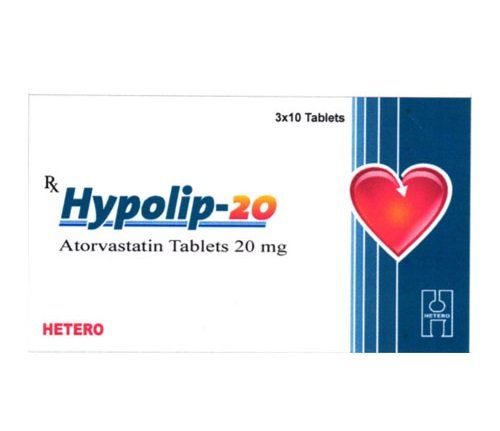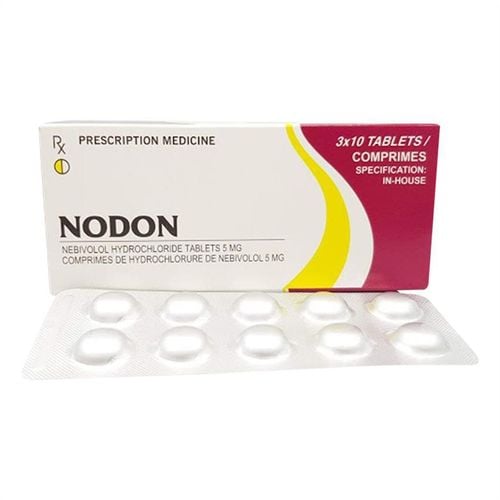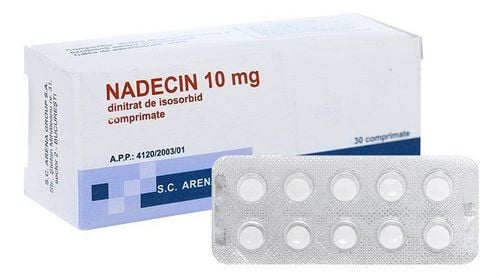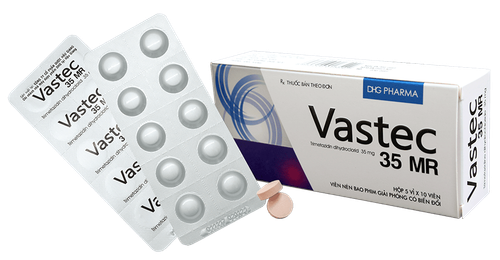This is an automatically translated article.
Atizet drug of An Thien Pharmaceutical Joint Stock Company, the main ingredients are ezetimibe, simvastatin. The drug is effective in the treatment of high blood cholesterol. On the market today, there is a lot of information about the drug Atizet plus 10mg, but it is still incomplete. To better understand what Atizet plus is, what is the use of Atizet, let's learn more in the article below.
1. What is Atizet and Atizet plus 10mg?
Drug Atizet: Belongs to the group of cardiovascular drugs. The drug is used as an adjunct to primary hypercholesterolemia, homozygous familial hypercholesterolemia and homozygous hyperbeta-sitosterol according to the doctor's prescription. In addition, the drug also works to prevent dangerous complications of cardiovascular disease.
Dosage form: Tablets
Packing: Box of 2 blisters x 10 tablets, box of 3 blisters x 10 tablets, box of 5 blisters x 10 tablets, box of 10 blisters x 10 tablets, box of 1 bottle x 60 tablets, box of 1 bottle x 100 tablets
Ingredients of Atizet: Atizet is made from 10mg of the active ingredient Ezetimibe and a sufficient amount of excipients in one tablet.
Atizet plus 10mg: Atizet plus 10mg is a drug for the treatment of cardiovascular diseases, blood lipid diseases. Specifically, the drug helps lower bad cholesterol and fat while increasing good cholesterol (HDL) in the blood. This helps patients reduce their risk of heart disease and helps prevent strokes and heart attacks.
Ingredients of Atizet plus: Ezetimibe 10 mg and Simvastatin 20 mg.
Dosage form: This drug is formulated in the form of tablets
1.1. Pharmacokinetics of Atizet Atizet Plus (ezetimibe/simvastatin) is a lipid-lowering agent that selectively inhibits the intestinal absorption of cholesterol and related plant sterols and inhibits endogenous cholesterol synthesis. Plasma cholesterol is made up of intestinal absorption and endogenous synthesis. Atizet Plus contains ezetimibe and simvastatin, two lipid-lowering ingredients with complementary mechanisms of action. Atizet Plus helps to lower total, LDL-C, Apo B, TG and non-HDL-C cholesterol, and increases HDL-C through dual inhibition of cholesterol absorption and synthesis.
Ezetimibe
Ezetimibe inhibits the absorption of cholesterol from the intestine. Ezetimibe is also active when administered orally and has a different mechanism of action from cholesterol-lowering drugs of other classes (e.g. statins, bile acid secretion (resin) inhibitors), fibric acid derivatives, and stanols with plant origin), responsible for the absorption of cholesterol and phytosterols from the gut.
Ezetimibe localizes to the brush border of the small intestine and inhibits cholesterol absorption, leading to reduced intestinal cholesterol transport: Statins reduce hepatic cholesterol synthesis and these two distinct mechanisms complement together to lower cholesterol.
Simvastatin
Simvastatin is an inactive lactone. After oral administration, simvastatin is hydrolyzed in the liver to the corresponding active form B-hydroxyacid, which has a strong effect on the inhibition of HMG - CoA reductase (3 hydroxy-3 methylglutaryl CoA reductase enzyme). This enzyme catalyzes the conversion of HMG-CoA to mevalonate and is the first and rate-limiting step in cholesterol biosynthesis.
Simvastatin has also been shown to reduce both normal and elevated LDL-C levels. LDL-C is formed from very low molecular weight (VLDL) proteins and is catabolized primarily by the high-affinity LDL receptor. The LDL-lowering mechanism, of simvastatin, may be due to a reduction in VLDL cholesterol (VLDL.-C) levels and stimulation of the LDL receptor, resulting in decreased production and increased catabolism of LDL-C. Apolipoprotein B was also significantly reduced during treatment with simvastatin. Furthermore, simvastatin also moderately increased HDL-C and decreased plasma TG. The result of these changes is a decrease in the total cholesterol ratio HDL-C and the ratio LDL-C/HDL-C.
1.2 Pharmacokinetics of the drug Atizet Absorption: Ezetimibe
After oral administration, ezetimibe is rapidly absorbed and strongly conjugated to form the pharmacologically active substance ezetimibe-glucuronide. Mean maximum plasma concentrations (Cmax) achieved are approximately 1 to 2 hours for ezetimibe-glucuronide and 4 to 12 hours for ezetimibe.
Administration with food (high-fat or fat-free meals) did not affect the oral bioavailability of ezetimibe when a 10 mg dose of ezetimibe was administered.
Simvastatin
The presence of β-hydroxyacid in the circulation following oral administration of simvastatin was found to be less than 5% of the dose consistent with extensive first-pass metabolism in the liver. The major metabolites of simvastatin present in human plasma are β-hydroxyacid and additional active metabolites. In the fasting state, neither the active inhibitor nor the total inhibitor in plasma will be affected if simvastatin is administered immediately before a meal.
Distribution of Ezetimibe
Ezetimibe and ezetimibe-glucuronide are 99.7% and 88 to 92% bound to human plasma proteins, respectively.
Simvastatin
Both simvastatin and β-hydroxyacid are bound to human serum proteins (95%). The pharmacokinetics of single and multiple doses of simvastatin showed no drug accumulation. In the above pharmacokinetic studies, maximum serum concentrations of the inhibitors occurred between 1.3 hours and 2.4 hours after administration.
Metabolism Ezetimibe
Ezetimibe is extensively metabolised in the small intestine and liver by conjugation with glucuronide (phase II reaction) and then excreted in the bile. Minimal oxidative metabolism (phase I reaction) was observed in all species studied. Ezetimibe and ezetimibe-glucuronide are the major metabolites of the drug that can be detected in plasma, accounting for about 10 to 20% and 80 to 90% of the total drug in plasma, respectively. Ezetimibe and ezetimibe-glucuronide are eliminated from plasma slowly with significant signs of intestinal reabsorption. The half-life of ezetimibe and ezetimibe-glucuronide is approximately 22 hours.
Simvastatin
Simvastatin is an inactive lactone that is rapidly hydrolysed in vivo to the corresponding β-hydroxyacid and a potent inhibitor of the enzyme HMG-CoA reductase. Hydrolysis occurs mainly in the liver and the rate of hydrolysis in human plasma is very slow. In humans, simvastatin is also well absorbed and undergoes extensive first-pass metabolism in the liver. The mean half-life of the β-hydroxyacid metabolite after intravenous administration is approximately 1.9 hours.
Elimination of Ezetimibe
In humans, after oral administration of 14C-ezetimibe (20 mg), total ezetimibe accounted for about 93% of the total radiolabeled active substance in plasma.
78% and 11% radiolabeled active substances were found in feces and urine collected for 10 days, respectively. After 48 hours, no radiolabelled active substances were detected in the plasma.
Simvastatin
In humans, after oral administration of a single dose of radiolabeled simvastatin, 13% of the radiolabelled active substance was excreted in the urine and 60% in the feces within 96 hours. The amount found in the faeces represents the amount of drug absorbed and excreted into bile equivalents as well as the amount not absorbed. Following an intravenous dose of the β-hydroxyacid metabolite, only an average of 0.3% of the intravenous dose was excreted in the urine as inhibitors.
2. What are the uses of Atizet?
The drug is taken with an appropriate diet to help lower bad cholesterol and fats (such as LDL , triglycerides) and increase good cholesterol (HDL) in the blood. The drug belongs to the "statin" class of drugs, which work by lowering cholesterol levels by the liver. Lowering bad cholesterol and triglycerides and raising good cholesterol reduces the risk of heart disease and helps prevent strokes and heart attacks.
In addition to an appropriate diet (such as a diet low in fat and cholesterol), lifestyle changes that can also help make this drug work better include exercise, weight loss if you are overweight weight and stop smoking. Consult your doctor for more details.
3. Side effects of Atizet plus 10mg
Allergies, rash, nausea Constipation, diarrhea, abdominal pain Side effects may not be the same, depending on the location of each person. Inform your doctor about any unwanted effects you may experience while taking this medicine.
4. Drug interactions
Atizet has the potential to interact with some other medications. This interaction will affect the therapeutic action of the drug. It also increases the incidence of serious side effects that affect health. Therefore, before using Atizet, the patient needs to talk to the doctor about the drugs that you are using. Medications you need to share with your doctor may include: Prescription drugs, over-the-counter drugs, supplements, vitamins, nutrients, and herbs.
Atizet will have the potential to interact strongly with the following medicines:
Anticoagulants Warfarin : Coumadin Drugs used to prevent transplant rejection in patients with heart, kidney or liver transplant Cyclosporine: Neoral, Sandimmune, Gengraf Cholestyramine: Prevalite, Questran Colesevelam: Welchol Gemfibrozil: Lopid Bile acid-binding resin Colestipol: Colestid.
5. How to use Atizet effectively
5.1. How to take Atizet is taken by mouth. Patients can take Atizet with or without food. For patients who frequently experience nausea while taking the drug, it is best to take Atizet with food. This will prevent you from having to take your medicine again when you vomit. For normal people, the patient should take the medicine with a full glass of water. Besides, before using Atizet, users should not crush the drug or break it in half and do not chew the medicine before swallowing.
In addition, before using the drug and during the use of Atizet, the patient should have an appropriate lipid diet. Atizet can be used alone or in combination with Fenofibrate and Statins. Patients can use the drug at any time.
Use Atizet Plus only for adults, not for children.
Patients should be on a cholesterol diet before starting Atizet Plus and should continue on a diet during treatment. Dosage should be individualized for each patient based on baseline LDL-C levels, therapeutic goals, and patient response.
It is recommended to take Atizet Plus only once in the evening, with or without food.
5.2. Dosage It is recommended to initiate treatment at the lowest effective dose of the drug.
Dose of Atizet Plus (ezetimibe/simvastatin respectively 10/20mg) take 1 tablet once only in the evening.
Concomitant treatment with other drugs
Atizet Plus should be administered ≥ 2 hours before or ≥ 4 hours after taking a drug that binds bile acids.
In patients receiving amiodarone, amlodipine, verapamil, diltiazem, lipid-lowering niacin (≥ 1g/day), concomitantly with Atizet Plus, the dose of Atizet Plus should not exceed 1 tablet/day (ezetimibe/simvastatin 10/20mg, respectively. )
Patients with renal impairment
No dosage adjustment is required for patients with moderate renal impairment. The drug should not be used in patients with severe renal impairment (creatinine clearance ≤ 30 ml/min).
Patients with hepatic impairment
No dose adjustment is required for patients with mild hepatic impairment (Child - Pugh score 5 or 6). Atizet Plus should not be used in patients with moderate hepatic impairment (Child-Pugh score 7 to 9) or severe hepatic impairment (Child-Pugh score > 9).
Elderly patients
No dose adjustment required.
Children
Not for use in children under 10 years of age, but the drug can also be considered for children over 10 years of age.
Note: The above dosage is for reference only. The specific dose will depend on the condition and the progression of the disease. To get the right dose, you need to consult with your doctor or medical professional.
5.3. What to do in case of overdose? There have been several cases of simvastatin overdose in humans. There are no long-term complications.
In studies, high doses of ezetimibe did not lead to serious problems. Of the few cases of overdose that have been reported, these symptoms were either mild or non-existent. No serious problems occurred.
Simvastatin
Several cases of overdose have been reported and the maximum dose used was 3.6g. All patients recovered without sequelae.
If an overdose of Atizet Plus occurs, gastric lavage or emetics may be used. Dialysis will likely not be able to remove the drug. Treatment may also involve supportive care, which includes treatment of symptoms occurring as a result of overdose, including:
Close monitoring of cardiac output, blood pressure, rhythm breathe. Intravenous (IV) fluids. Other treatments will be based on the complications that occur. 5.4. What to do if you miss a dose? If you forget a dose, take it as soon as you remember. But, when it is almost time for your next dose, skip the missed dose and take your next dose at the scheduled time. It should be noted that double the prescribed dose should not be used.
5.5. What to do in case of overdose? In case of drug overdose or taking too much medicine that requires emergency care, family members need to bring the prescription/vial of medicine the victim has taken. In addition, family members also need to know the height and weight of the victim to inform the doctor.
6. Be careful and store when using medicine
Before using and during the use of Atizet, the patient should be careful with the following:
The patient should only use Atizet when required and prescribed by a specialist doctor. If you are taking this medicine, you should tell your doctor if you are likely to be allergic to any of its ingredients. Then the doctor may give you an alternative medicine or will help you change the treatment regimen During the time of using Atizet, the patient needs to stop using the drug and notify the specialist When the body shows many abnormal signs, allergies or serious side effects that affect health When using Atizet and HMG CoA reductase inhibitors, the patient needs to take the drug according to the instructions. Strictly from the doctor Pregnant women should also not use Atizet. Because the ingredients in the drug have the ability to affect and increase the incidence of serious side effects that affect the health of the fetus. Women who are breastfeeding should not use the drug. Because the ingredients in the drug Atizet also have the ability to pass through breast milk to young children and cause poisoning. Patients with severe liver failure or chronic liver disease should not use the drug. Patients with mild liver failure, kidney failure If you want to use the drug, it is necessary to have strict monitoring and prescribed dosage from a specialist. Patients should not drive and operate machinery while using Atizet. Because the drug has the potential to make you seriously drowsy and dizzy Before using Atizet, the patient needs to inform the doctor about your medical history and current medical condition. doctor about the medicines you are taking before taking Atizet. This can help you avoid drug interactions that affect your health. Medications you need to share with your doctor may include: Prescription drugs, over-the-counter medicines, supplements, vitamins, nutrients and herbs Patients should not take more than Atizet. prescribed dose Do not use expired Atizet. Store in a dry place at a temperature not exceeding 30°C and protected from light.
Please dial HOTLINE for more information or register for an appointment HERE. Download MyVinmec app to make appointments faster and to manage your bookings easily.













